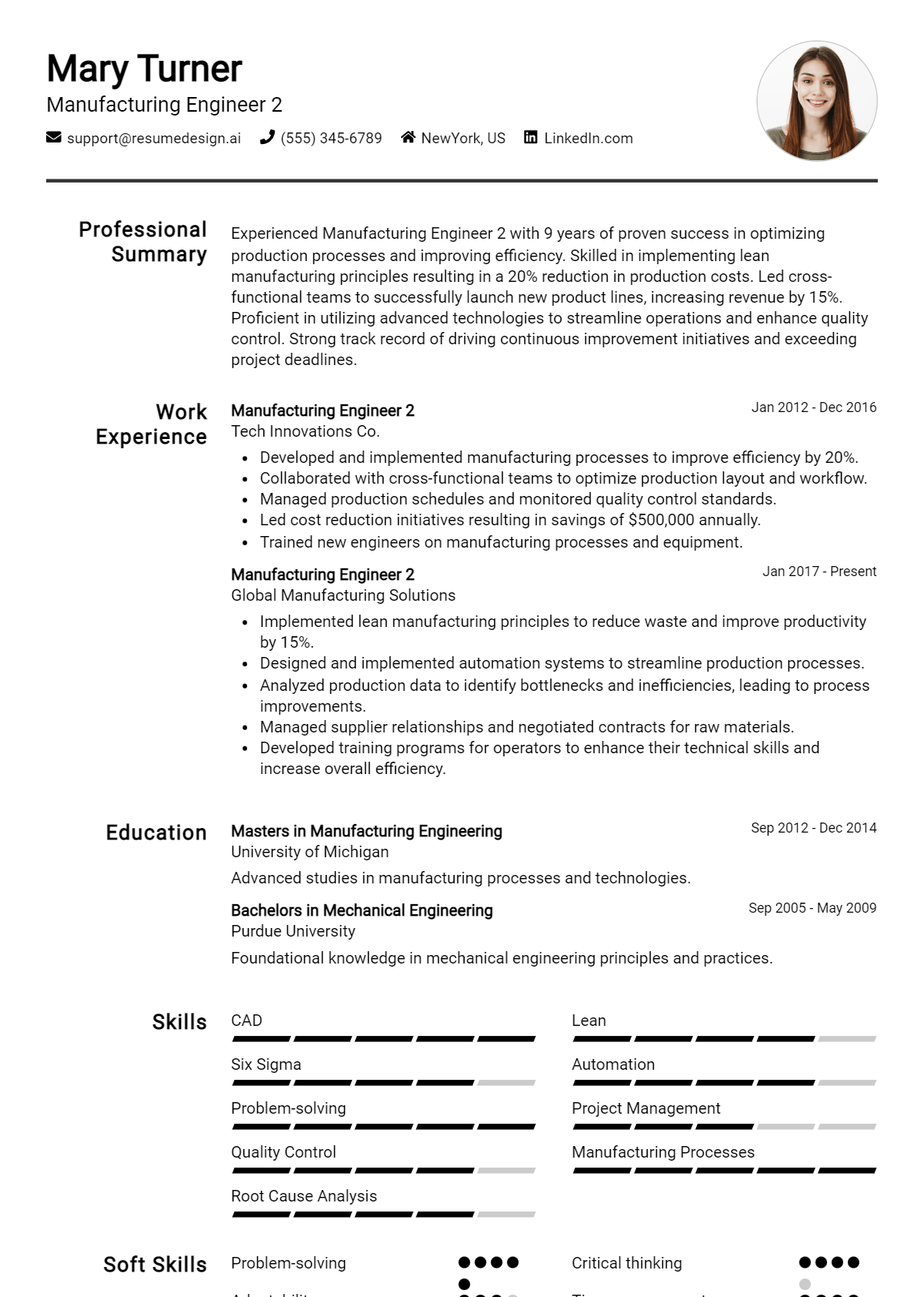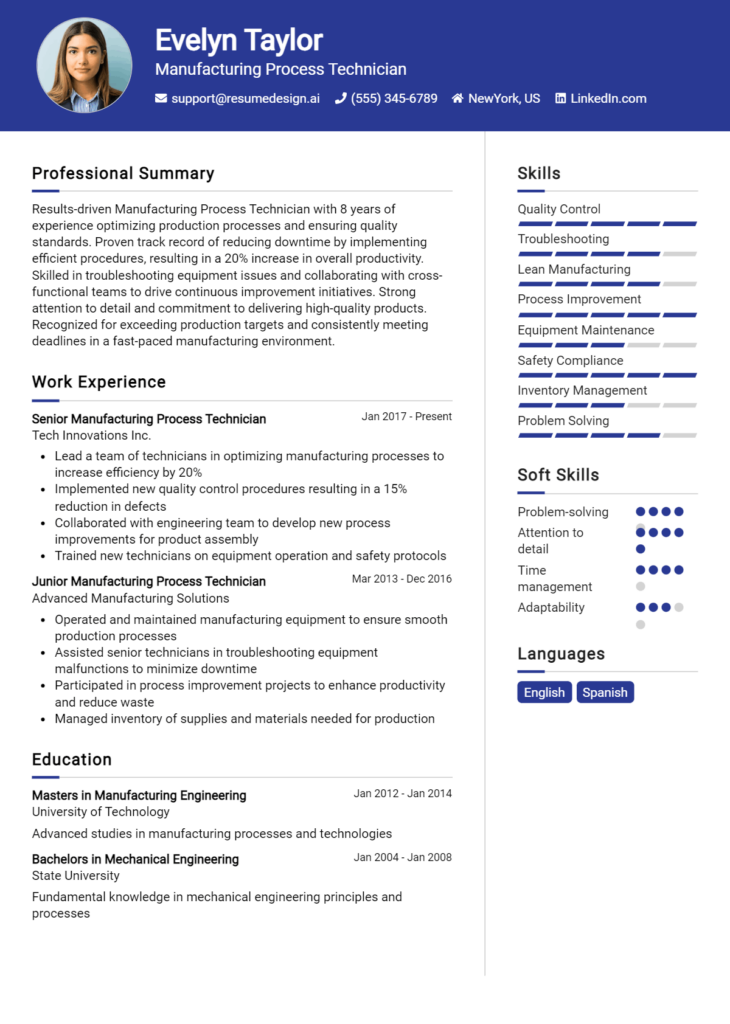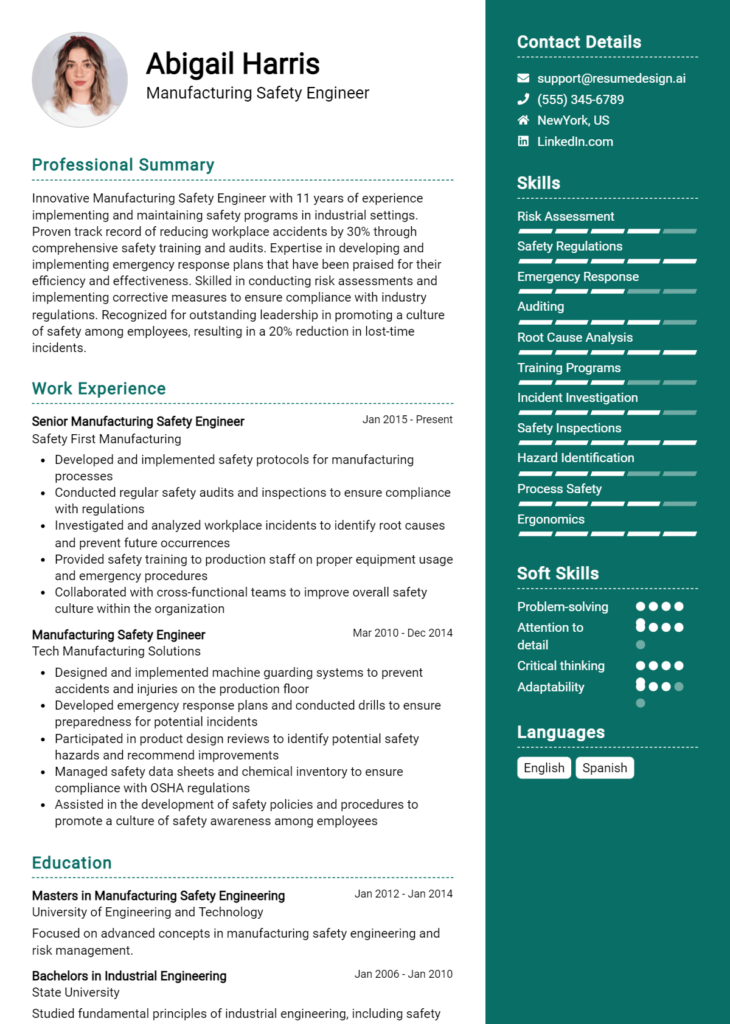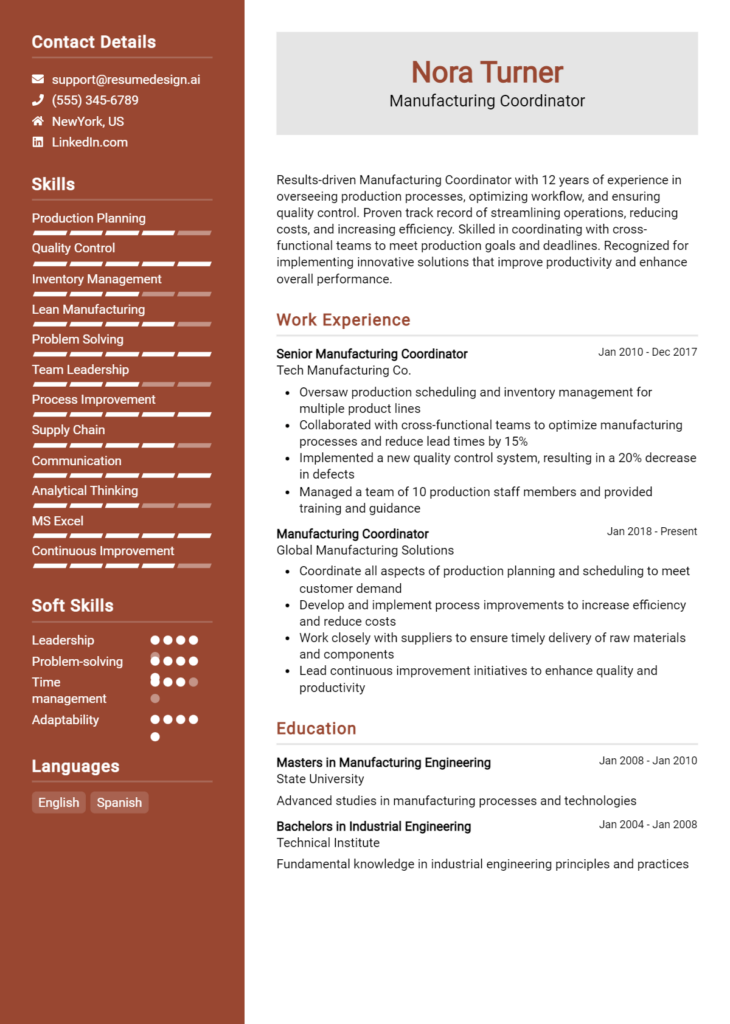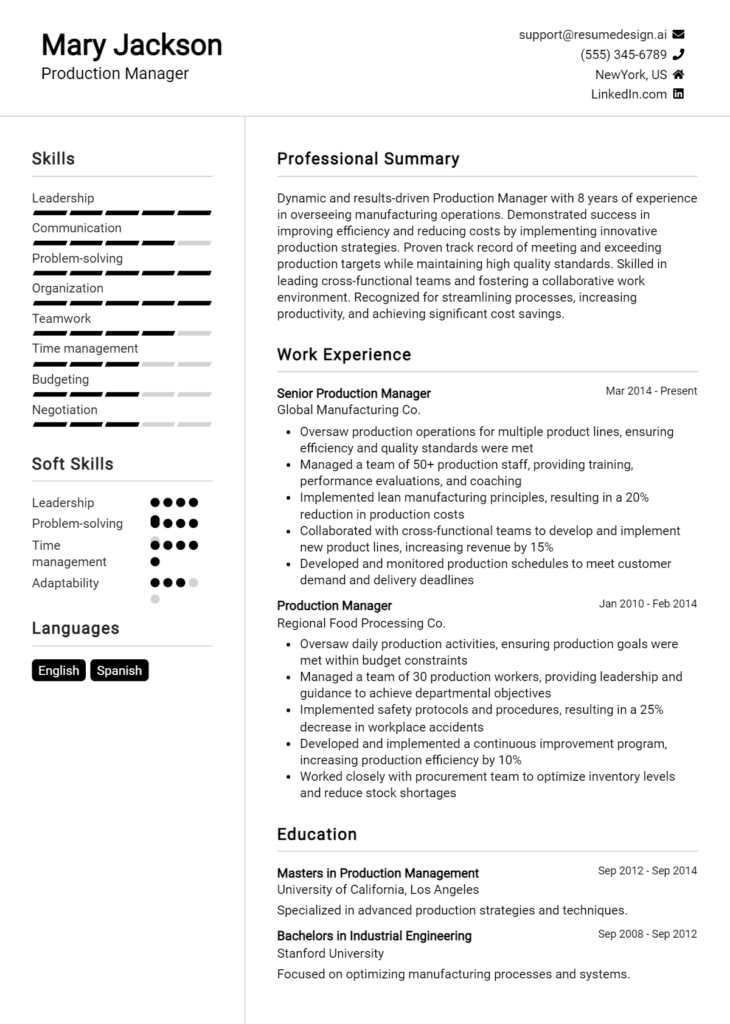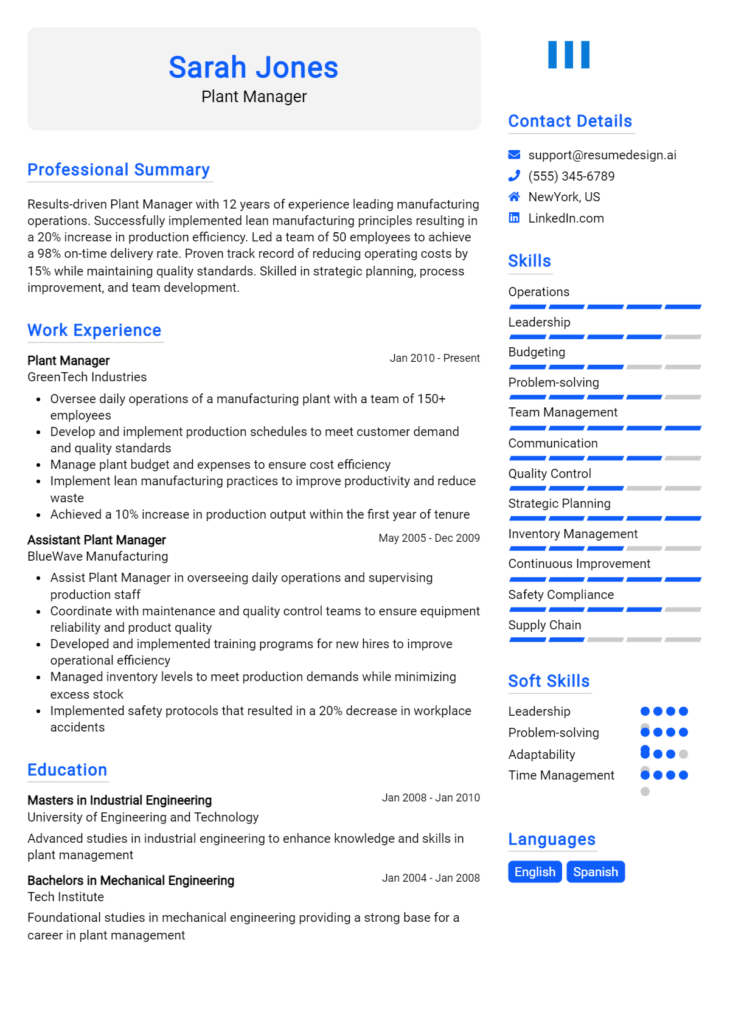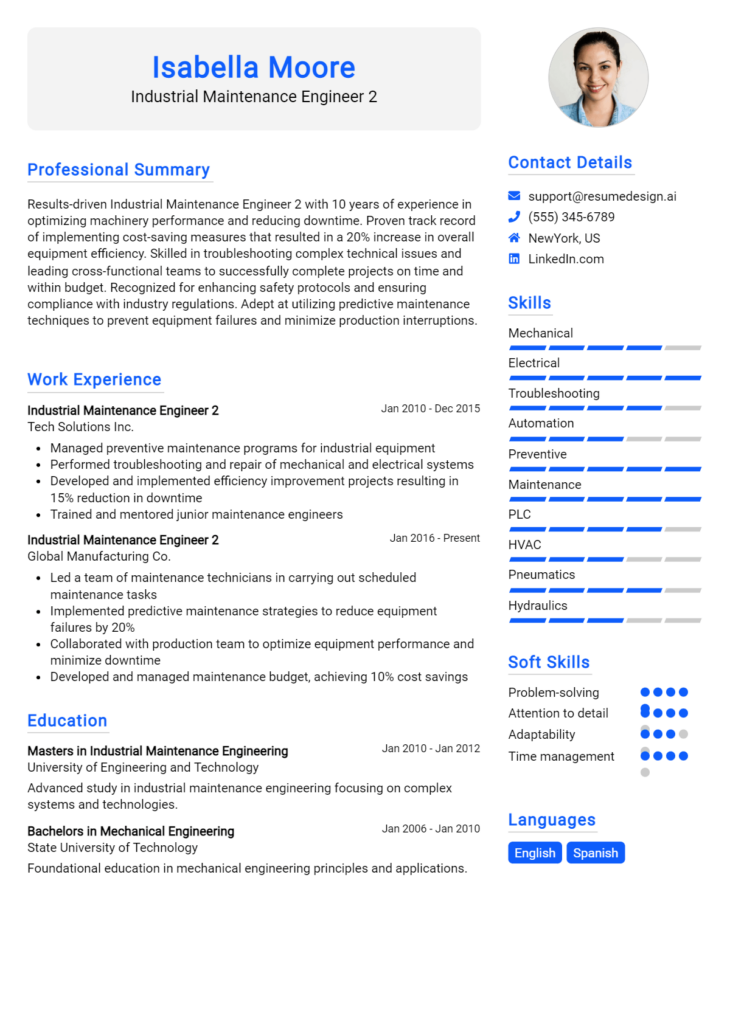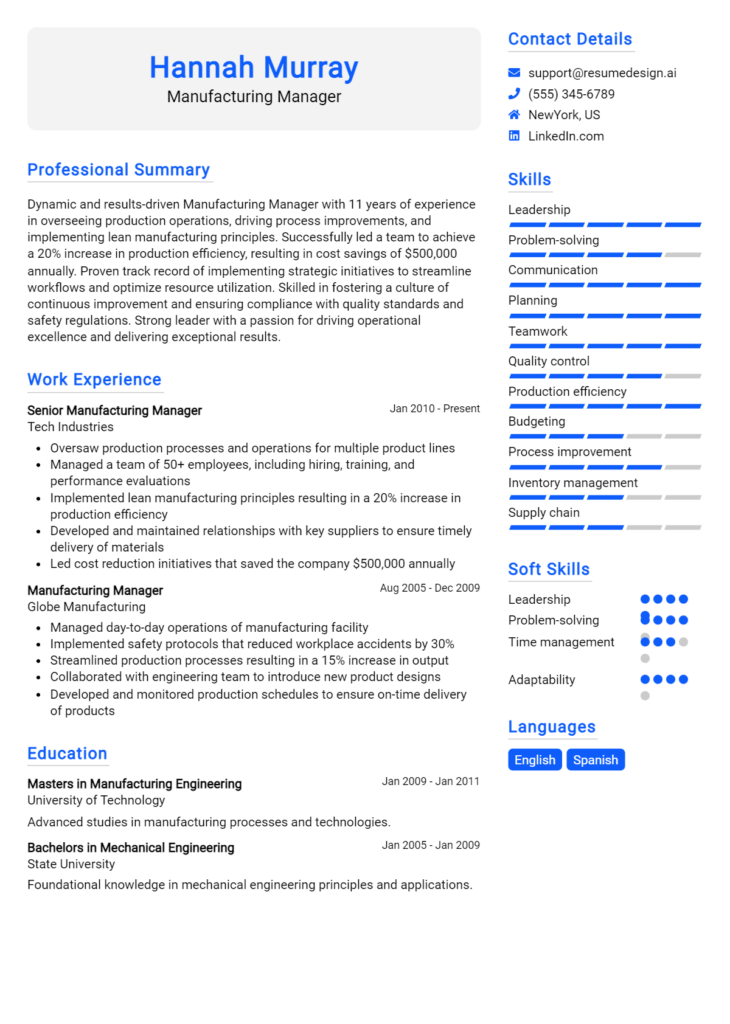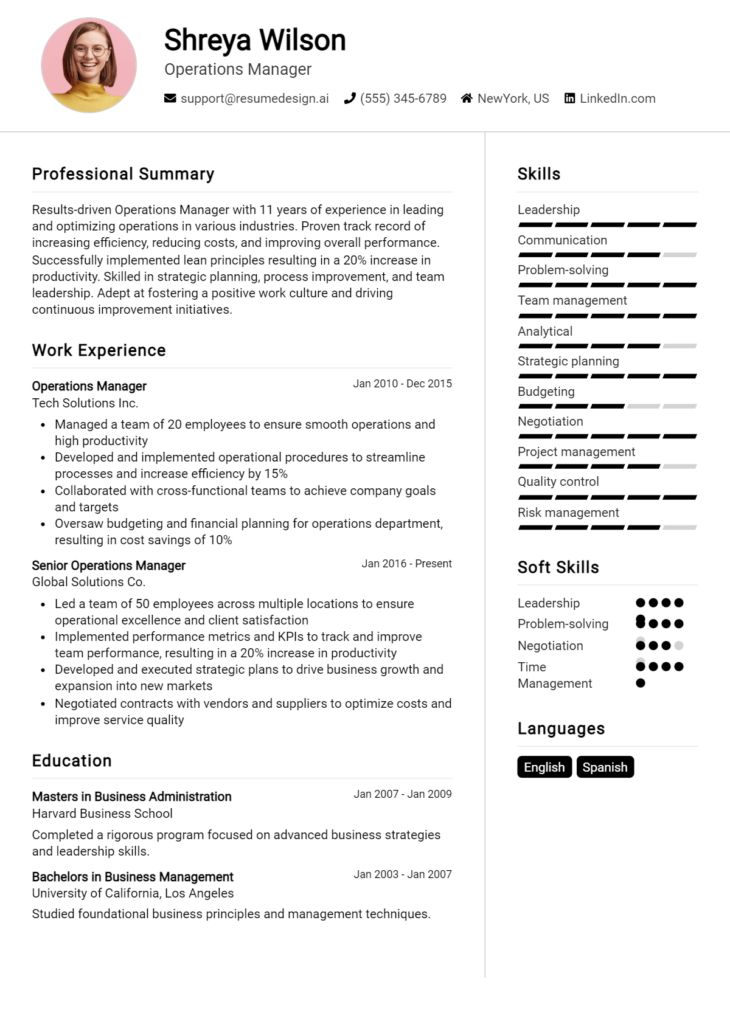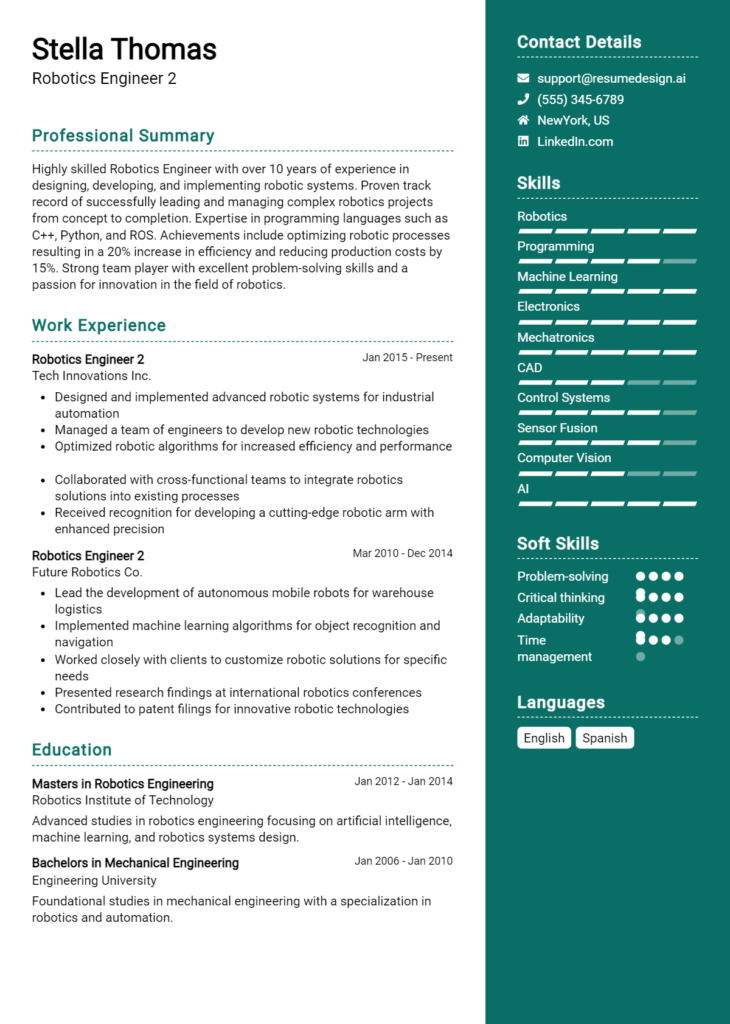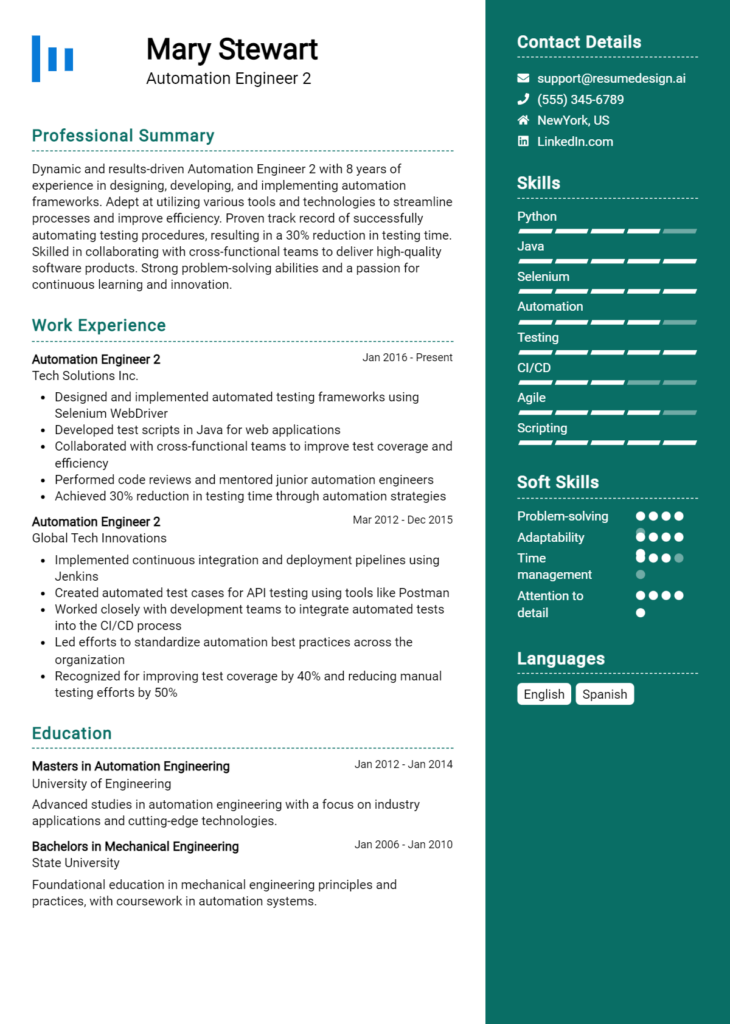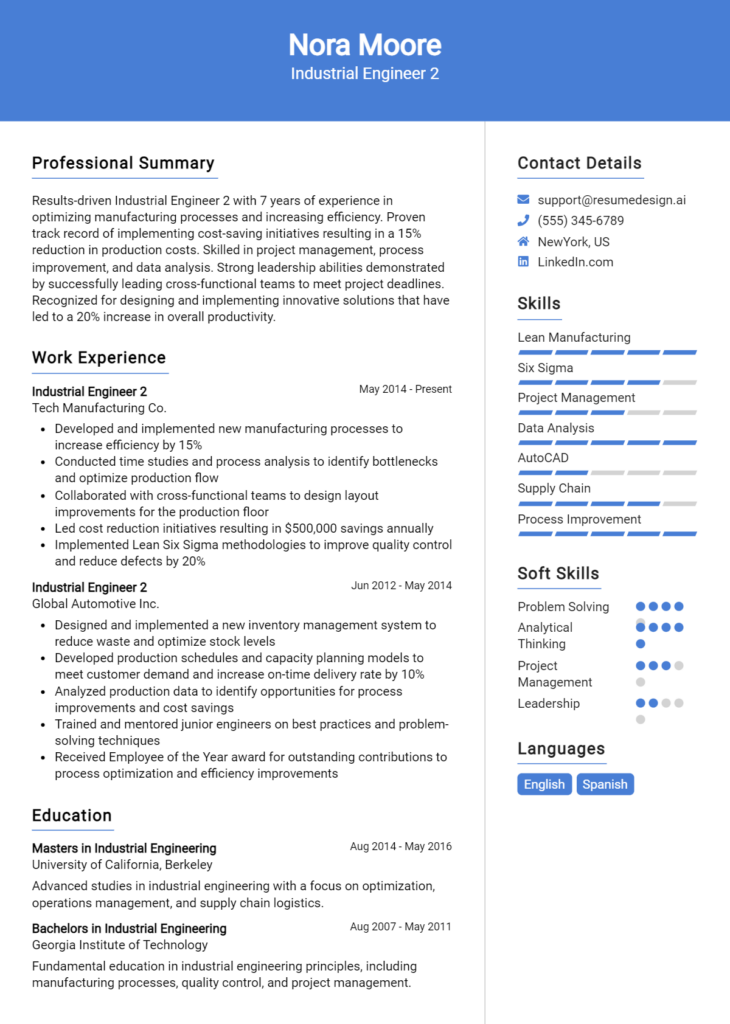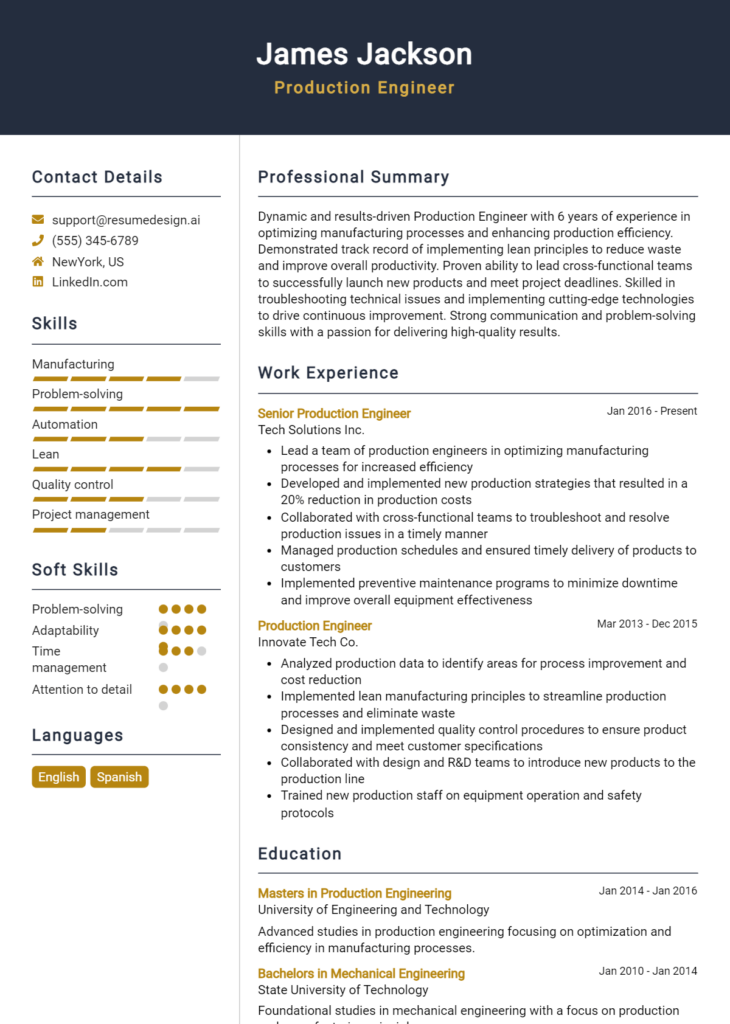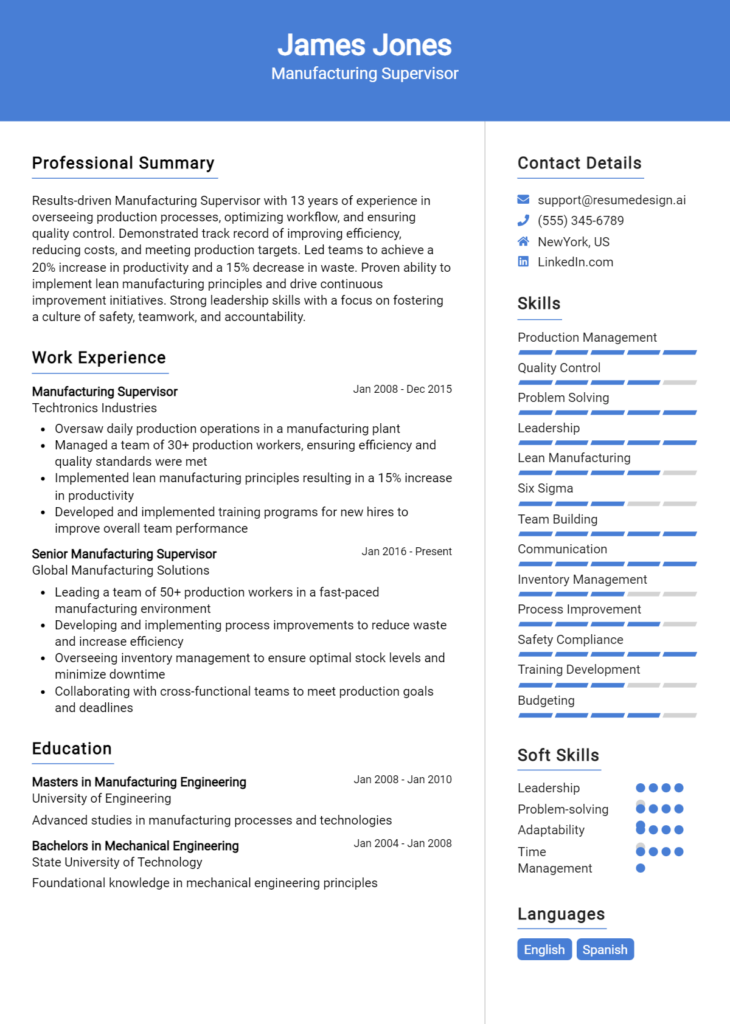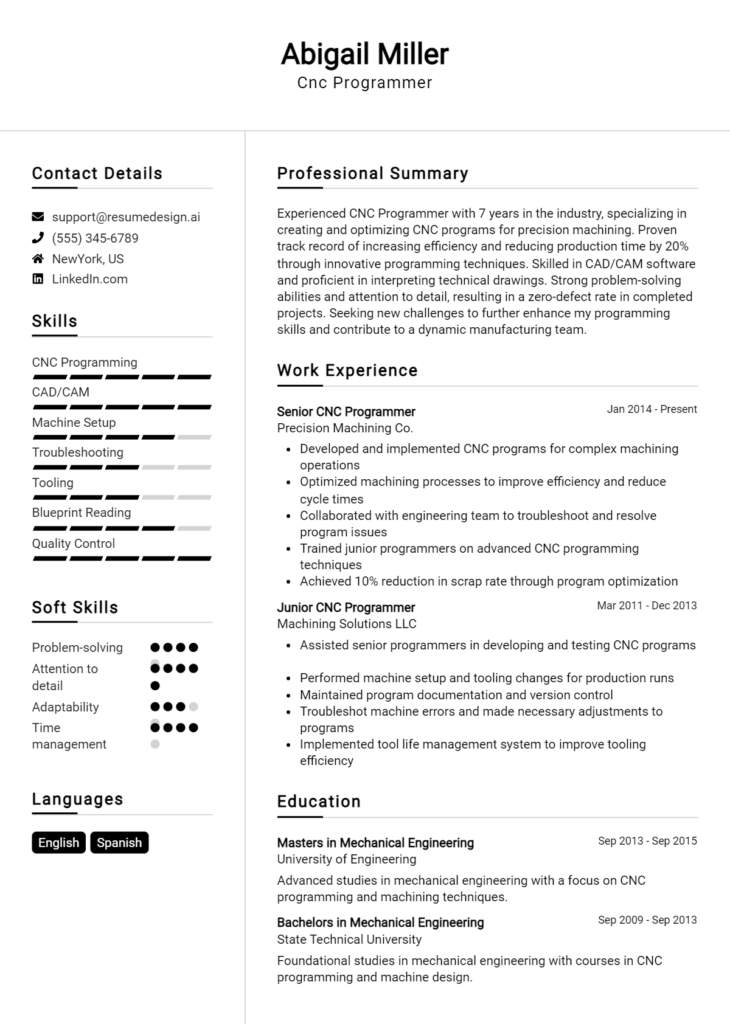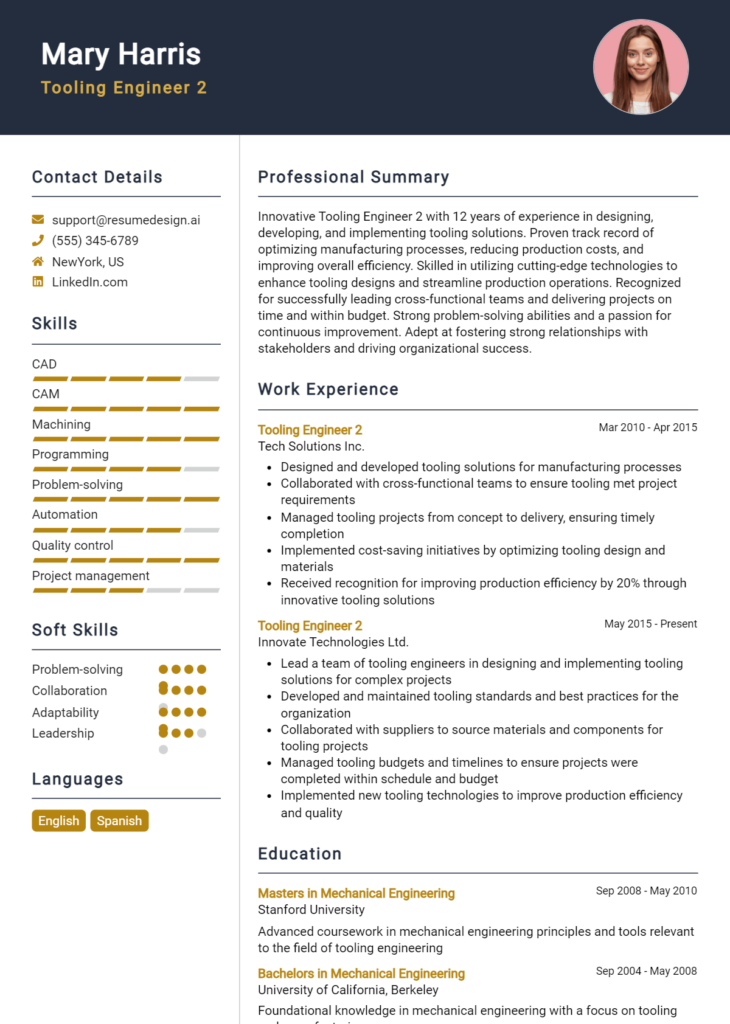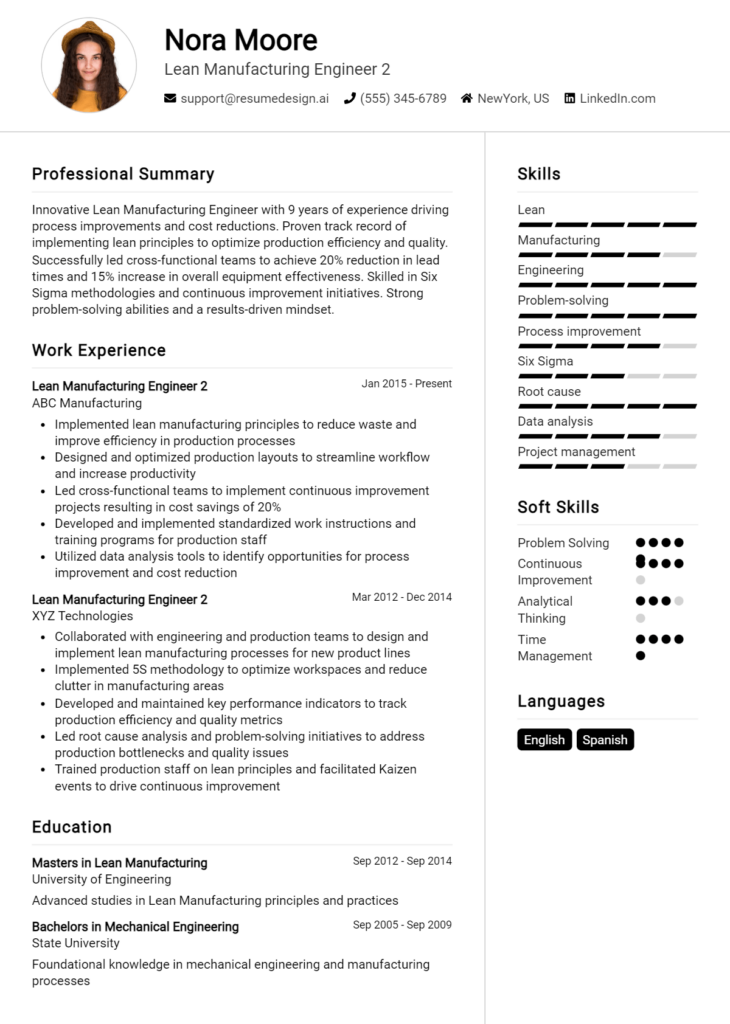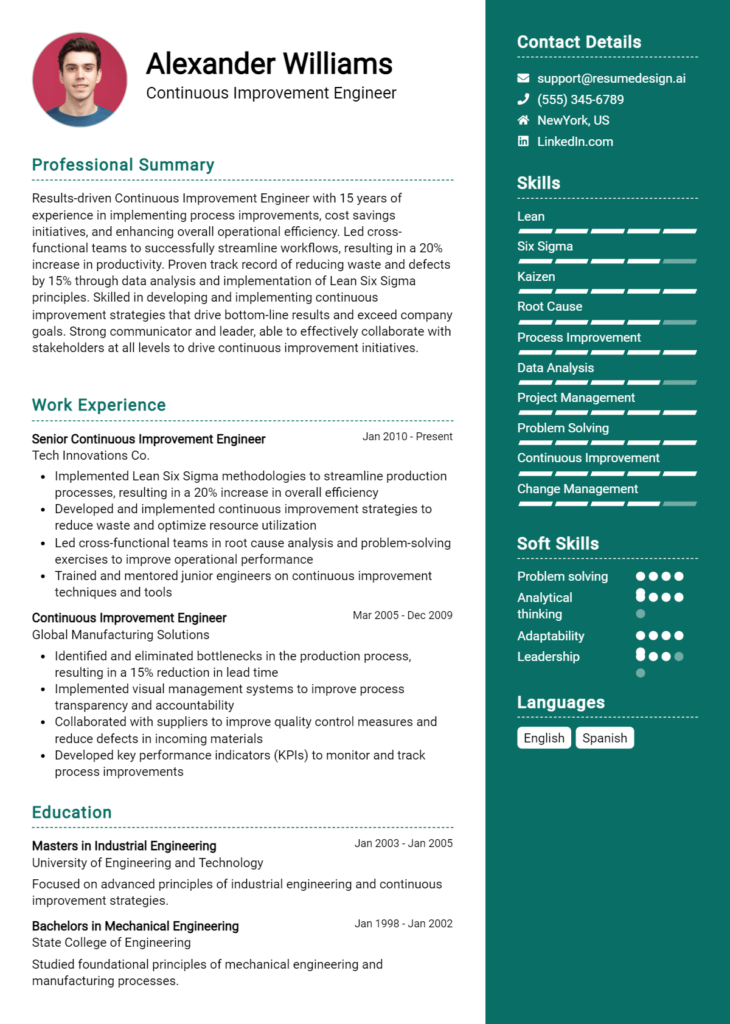Manufacturing Engineer Core Responsibilities
A Manufacturing Engineer plays a crucial role in optimizing production processes, ensuring product quality, and enhancing operational efficiency. This position requires strong technical skills, operational expertise, and exceptional problem-solving abilities to effectively bridge engineering, production, and quality assurance departments. By streamlining workflows and implementing innovative solutions, Manufacturing Engineers contribute significantly to organizational goals. A well-structured resume showcasing these qualifications can effectively highlight their value, making them standout candidates in the competitive job market.
Common Responsibilities Listed on Manufacturing Engineer Resume
- Design and implement efficient manufacturing processes.
- Analyze production data to identify areas for improvement.
- Collaborate with cross-functional teams to resolve production issues.
- Develop and maintain process documentation and standards.
- Conduct root cause analysis for quality concerns.
- Optimize equipment utilization and reduce downtime.
- Lead continuous improvement initiatives using lean methodologies.
- Train staff on new processes and technologies.
- Ensure compliance with safety and environmental regulations.
- Oversee project timelines and budgets for manufacturing projects.
- Evaluate and select suppliers for quality and cost-effectiveness.
- Implement automation solutions to enhance productivity.
High-Level Resume Tips for Manufacturing Engineer Professionals
In the competitive landscape of manufacturing engineering, a well-crafted resume serves as a critical tool for professionals seeking to make a strong first impression on potential employers. Your resume is often the initial point of contact and can significantly influence an employer's perception of your qualifications. It should not only reflect your technical skills and industry expertise but also showcase your achievements in a way that captures attention. This guide will provide practical and actionable resume tips specifically tailored for Manufacturing Engineer professionals, enabling you to effectively communicate your value in this dynamic field.
Top Resume Tips for Manufacturing Engineer Professionals
- Tailor your resume to the specific job description by incorporating relevant keywords and phrases.
- Highlight your relevant experience, focusing on projects that demonstrate your engineering skills and problem-solving abilities.
- Quantify your achievements with metrics and statistics to illustrate your impact, such as cost savings, efficiency improvements, or production increases.
- Showcase your industry-specific skills, including proficiency in manufacturing software, quality control techniques, and lean manufacturing principles.
- Include certifications and licenses that are pertinent to the manufacturing engineering field, such as Six Sigma or PMP.
- Emphasize your ability to work collaboratively in cross-functional teams and your experience in project management.
- Utilize a clear and professional format that enhances readability and highlights your key qualifications.
- Incorporate a summary statement at the top of your resume that encapsulates your career goals and relevant experience.
- Keep your resume concise, ideally one to two pages, while ensuring that all critical information is easily accessible.
By implementing these tips, you can significantly enhance your resume's effectiveness, increasing your chances of landing a job in the Manufacturing Engineer field. A resume that clearly communicates your qualifications and achievements will help you stand out in a competitive job market, making it more likely that employers will take notice of your potential and invite you for an interview.
Why Resume Headlines & Titles are Important for Manufacturing Engineer
In the competitive landscape of manufacturing engineering, a well-crafted resume headline or title can be a game-changer. It serves as the first impression a hiring manager will have of a candidate, encapsulating their key qualifications in a concise and impactful phrase. A strong headline not only grabs attention but also immediately communicates the applicant's value proposition, making it essential for standing out in a crowded applicant pool. When tailored specifically to the job being applied for, these headlines can significantly enhance the effectiveness of a resume, ensuring that the candidate is seen as a suitable match for the role.
Best Practices for Crafting Resume Headlines for Manufacturing Engineer
- Keep it concise and to the point, ideally under 10 words.
- Use industry-specific terminology to demonstrate expertise.
- Highlight key skills or achievements relevant to the position.
- Tailor the headline for each job application for maximum relevance.
- Incorporate measurable results or certifications when possible.
- Avoid vague language; be specific about your role and impact.
- Focus on what sets you apart from other candidates.
- Use action-oriented language that conveys confidence.
Example Resume Headlines for Manufacturing Engineer
Strong Resume Headlines
Results-Driven Manufacturing Engineer with 10+ Years of Lean Expertise
Innovative Manufacturing Engineer Specializing in Process Optimization
Certified Six Sigma Black Belt Focused on Quality Improvement
Experienced Manufacturing Engineer with Proven Track Record in Automation
Weak Resume Headlines
Manufacturing Engineer Seeking Job
Engineer with Experience
The strong headlines are effective because they provide clear, specific, and relevant information about the candidate's skills and experience, instantly positioning them as a strong contender for the role. In contrast, the weak headlines fall flat due to their vagueness and lack of detail, failing to convey any unique qualifications or value that would capture the interest of hiring managers. By avoiding generic phrases and instead focusing on distinct attributes, candidates can create impactful headlines that resonate with potential employers.
Writing an Exceptional Manufacturing Engineer Resume Summary
A resume summary is a crucial element for a Manufacturing Engineer, as it serves as the first impression a candidate makes on hiring managers. It succinctly highlights key skills, relevant experience, and notable accomplishments, allowing recruiters to quickly gauge the applicant's suitability for the role. A well-crafted summary not only captures attention but also sets the tone for the rest of the resume, making it essential for candidates to ensure their summaries are concise, impactful, and tailored to the specific job they are applying for.
Best Practices for Writing a Manufacturing Engineer Resume Summary
- Quantify Achievements: Use numbers to illustrate your successes, such as percentage improvements or cost savings.
- Focus on Relevant Skills: Highlight technical and soft skills that are most applicable to the job description.
- Tailor for the Job: Customize your summary for each application to align with the specific requirements of the role.
- Keep it Concise: Limit your summary to 3-5 sentences for clarity and impact.
- Use Action Verbs: Start sentences with strong action verbs to convey confidence and initiative.
- Highlight Industry Knowledge: Mention familiarity with relevant manufacturing technologies, methodologies, or standards.
- Showcase Problem-Solving Abilities: Emphasize your capacity to tackle challenges and implement improvements.
- Incorporate Keywords: Use terminology from the job description to pass through applicant tracking systems.
Example Manufacturing Engineer Resume Summaries
Strong Resume Summaries
Results-driven Manufacturing Engineer with over 8 years of experience in optimizing production processes, achieving a 20% reduction in cycle time and a 15% decrease in waste. Proficient in Lean Manufacturing and Six Sigma methodologies, with a proven track record of implementing cost-saving initiatives.
Detail-oriented Manufacturing Engineer skilled in CAD software and automation technologies, leading to a 30% increase in productivity over the last year. Adept at cross-functional collaboration to enhance operational efficiency and quality control.
Innovative Manufacturing Engineer with expertise in process improvement and project management. Successfully led a team that reduced downtime by 25% and improved product quality metrics by 10%, demonstrating strong leadership and technical skills.
Weak Resume Summaries
Manufacturing Engineer with experience in various manufacturing processes. I strive to do my best at work.
Skilled engineer looking for opportunities to improve manufacturing operations and contribute to team success.
The examples provided illustrate the differences between strong and weak resume summaries. Strong summaries are specific, quantify achievements, and directly relate to the roles typically expected of a Manufacturing Engineer, showcasing relevant skills and results. In contrast, weak summaries lack detail and specificity, failing to demonstrate the candidate's value or unique contributions, which can leave hiring managers underwhelmed and uninspired to consider the applicant further.
Work Experience Section for Manufacturing Engineer Resume
The work experience section is a critical component of a Manufacturing Engineer's resume, as it provides a comprehensive overview of the candidate's technical skills, leadership capabilities, and their ability to deliver high-quality products. This section not only highlights the applicant's past roles and responsibilities but also quantifies their achievements, making it easier for hiring managers to assess their fit for the position. Aligning experiences with industry standards and using metrics to showcase success are crucial for standing out in a competitive job market.
Best Practices for Manufacturing Engineer Work Experience
- Use clear and concise language to describe roles and responsibilities.
- Quantify achievements with specific metrics (e.g., percentage improvements, cost reductions).
- Highlight technical expertise with relevant tools, software, and methodologies.
- Emphasize collaboration by mentioning cross-functional teams or partnerships.
- Tailor experiences to align with the job description and industry standards.
- Include leadership roles and initiatives that demonstrate your ability to guide teams.
- Focus on outcomes that showcase problem-solving skills and innovation.
- Utilize action verbs to convey a sense of proactivity and impact.
Example Work Experiences for Manufacturing Engineer
Strong Experiences
- Led a cross-functional team to redesign a manufacturing process, resulting in a 20% increase in efficiency and a 15% reduction in production costs.
- Implemented a new quality control system that reduced product defects by 30%, significantly improving customer satisfaction ratings.
- Developed and launched a training program for new manufacturing technologies, enhancing team skills and decreasing onboarding time by 40%.
- Managed a project to upgrade machinery, which improved production speed by 25% and was completed under budget by 10%.
Weak Experiences
- Worked on various engineering projects.
- Assisted in improving manufacturing processes.
- Involved in team meetings and discussions.
- Responsible for ensuring quality in the production line.
The examples provided are considered strong because they highlight specific, quantifiable outcomes resulting from the candidate's actions, demonstrating a clear impact on the organization. In contrast, the weak experiences lack detail and measurable results, making it difficult for a hiring manager to gauge the candidate's contributions or skills effectively. Strong experiences convey leadership, technical proficiency, and collaboration, while weak experiences are vague and do not provide any real evidence of the candidate's capabilities.
Education and Certifications Section for Manufacturing Engineer Resume
The education and certifications section of a Manufacturing Engineer resume is crucial for showcasing a candidate's academic background and commitment to the field. It highlights not only the foundational knowledge acquired through formal education but also the industry-relevant certifications that demonstrate specialized skills and expertise. This section serves to validate the candidate's qualifications, emphasizing their dedication to continuous learning and professional development. By including relevant coursework, certifications, and any specialized training, candidates can significantly enhance their credibility and align themselves with the specific requirements of the job role, making a strong case for their suitability as a manufacturing engineer.
Best Practices for Manufacturing Engineer Education and Certifications
- Include degrees from accredited institutions relevant to engineering or manufacturing.
- List certifications from recognized industry organizations such as ASME or SME.
- Highlight coursework that aligns with the specific responsibilities of the job you are applying for.
- Emphasize advanced degrees or specialized training that demonstrate a higher level of expertise.
- Use specific titles for certifications and include the date obtained to show currency.
- Keep the section organized, using bullet points for clarity and readability.
- Update the section regularly to reflect new certifications or courses completed.
- Tailor the information to match the job description, focusing on the most relevant qualifications.
Example Education and Certifications for Manufacturing Engineer
Strong Examples
- Bachelor of Science in Manufacturing Engineering, University of Michigan, 2020
- Certified Manufacturing Engineer (CMfgE), Society of Manufacturing Engineers, 2022
- Lean Six Sigma Green Belt Certification, American Society for Quality, 2021
- Relevant Coursework: Advanced Manufacturing Processes, Quality Control Systems, CAD/CAM Applications
Weak Examples
- Associate Degree in General Studies, Community College, 2018
- Certification in Microsoft Office Suite, 2019
- High School Diploma, 2016
- Outdated certification in ISO 9001 from 2010
The strong examples are considered effective because they directly relate to the qualifications expected of a manufacturing engineer, showcasing relevant degrees, recognized certifications, and applicable coursework that align with industry standards. In contrast, the weak examples reflect irrelevant or outdated qualifications that do not support the candidate's suitability for the role, such as degrees that lack a focus on engineering and certifications that are no longer pertinent to current manufacturing practices.
Top Skills & Keywords for Manufacturing Engineer Resume
In the competitive field of manufacturing engineering, a well-crafted resume that highlights relevant skills is crucial for standing out to potential employers. Skills not only showcase your technical proficiency and ability to solve problems but also demonstrate your capacity to work collaboratively within a team and adapt to new challenges. A robust combination of hard and soft skills can set you apart, making it essential to carefully curate these aspects on your resume. By focusing on the right skills, you can effectively communicate your value to hiring managers and increase your chances of landing your desired position. For more insights on how to effectively present your skills and work experience, continue reading.
Top Hard & Soft Skills for Manufacturing Engineer
Soft Skills
- Problem-Solving
- Team Collaboration
- Communication Skills
- Adaptability
- Critical Thinking
- Time Management
- Attention to Detail
- Leadership
- Decision-Making
- Conflict Resolution
- Creativity
- Interpersonal Skills
- Continuous Learning
- Project Management
Hard Skills
- CAD Software Proficiency
- Lean Manufacturing Techniques
- Process Improvement
- Quality Control and Assurance
- Statistical Process Control (SPC)
- Robotics and Automation
- Six Sigma Methodologies
- Materials Science
- Manufacturing Processes and Technologies
- Product Lifecycle Management (PLM)
- Cost Analysis
- Technical Documentation
- Safety Standards and Compliance
- Troubleshooting and Maintenance
Stand Out with a Winning Manufacturing Engineer Cover Letter
Dear [Hiring Manager's Name],
I am writing to express my interest in the Manufacturing Engineer position at [Company Name] as advertised on [Job Board/Company Website]. With a Bachelor’s degree in Mechanical Engineering and over five years of experience in manufacturing processes and systems, I am excited about the opportunity to contribute my expertise in process optimization and efficiency improvements to your team. My hands-on experience in lean manufacturing techniques and my commitment to quality assurance align well with the goals of [Company Name].
In my previous role at [Previous Company Name], I successfully led a cross-functional team to implement a new production line that increased output by 30% while reducing waste by 15%. I have a proven track record of utilizing Six Sigma methodologies to identify bottlenecks and enhance operational workflows, resulting in significant cost savings and increased productivity. My ability to analyze complex manufacturing processes and develop innovative solutions has consistently yielded measurable improvements, and I am eager to bring this skill set to [Company Name].
Moreover, I am well-versed in utilizing advanced manufacturing technologies, including CAD software and ERP systems, to streamline production and improve quality control. My collaborative approach, combined with strong communication skills, allows me to work effectively with diverse teams and engage stakeholders across all levels of the organization. I am particularly drawn to [Company Name] because of your commitment to innovation and sustainability in manufacturing, and I am excited about the prospect of contributing to projects that not only enhance efficiency but also promote environmental responsibility.
Thank you for considering my application. I look forward to the opportunity to discuss how my background and skills would be a perfect fit for the Manufacturing Engineer position at [Company Name]. I am enthusiastic about the possibility of contributing to your team and am eager to bring my passion for manufacturing excellence to your organization.
Sincerely,
[Your Name]
[Your Phone Number]
[Your Email Address]
Common Mistakes to Avoid in a Manufacturing Engineer Resume
When crafting a resume for a Manufacturing Engineer position, it's crucial to present your skills, experiences, and achievements effectively. However, many candidates fall into common traps that can undermine their chances of landing an interview. Avoiding these pitfalls can significantly improve your resume's impact and ensure that you stand out in a competitive job market. Here are some common mistakes to watch out for:
Generic Objective Statement: Using a vague objective statement can make your resume blend in with others. Tailor your objective to the specific role and company to demonstrate your genuine interest.
Neglecting Relevant Skills: Failing to highlight key skills relevant to manufacturing engineering can lead to missed opportunities. Focus on technical skills such as CAD software proficiency, process optimization, and quality control methodologies.
Overloading with Jargon: While technical terms are important, overloading your resume with industry jargon can make it difficult for hiring managers to understand your qualifications. Strive for clarity and balance.
Lack of Quantifiable Achievements: Simply listing job duties without quantifying your accomplishments can weaken your resume. Use metrics to demonstrate your impact, such as percentage improvements in efficiency or cost savings achieved.
Ignoring Formatting Consistency: Inconsistency in formatting can create a disorganized appearance. Ensure uniformity in font size, style, bullet points, and spacing to enhance readability.
Including Irrelevant Experience: Listing unrelated jobs can distract from your qualifications. Focus on experiences that showcase your engineering skills and relate directly to the manufacturing field.
Omitting Keywords from Job Descriptions: Many companies use applicant tracking systems (ATS) to filter resumes. Failing to incorporate relevant keywords from the job description can result in your resume being overlooked.
Typos and Grammatical Errors: Simple mistakes can convey a lack of attention to detail, a crucial quality for a Manufacturing Engineer. Thoroughly proofread your resume to eliminate any errors before submitting it.
Conclusion
As a Manufacturing Engineer, your role is crucial in optimizing production processes, ensuring quality control, and implementing cost-effective solutions. Throughout this article, we've explored the essential skills and qualifications needed to excel in this field, including problem-solving abilities, technical knowledge, and project management expertise. We also discussed the significance of tailoring your resume to highlight your accomplishments and relevant experience in manufacturing engineering.
To stand out in a competitive job market, it's essential to present your qualifications effectively. Take the time to review your Manufacturing Engineer resume and ensure it showcases your skills and achievements clearly. Consider utilizing the following resources to enhance your application:
- Explore a variety of resume templates to find a design that best represents your professional persona.
- Utilize a resume builder for a user-friendly way to create a polished and tailored resume.
- Check out resume examples for inspiration on how to frame your experiences and skills.
- Don't forget to craft a compelling cover letter using cover letter templates that complement your resume and highlight your motivation for the role.
By leveraging these tools, you can enhance your resume and increase your chances of landing that ideal Manufacturing Engineer position. Start refining your application today!

